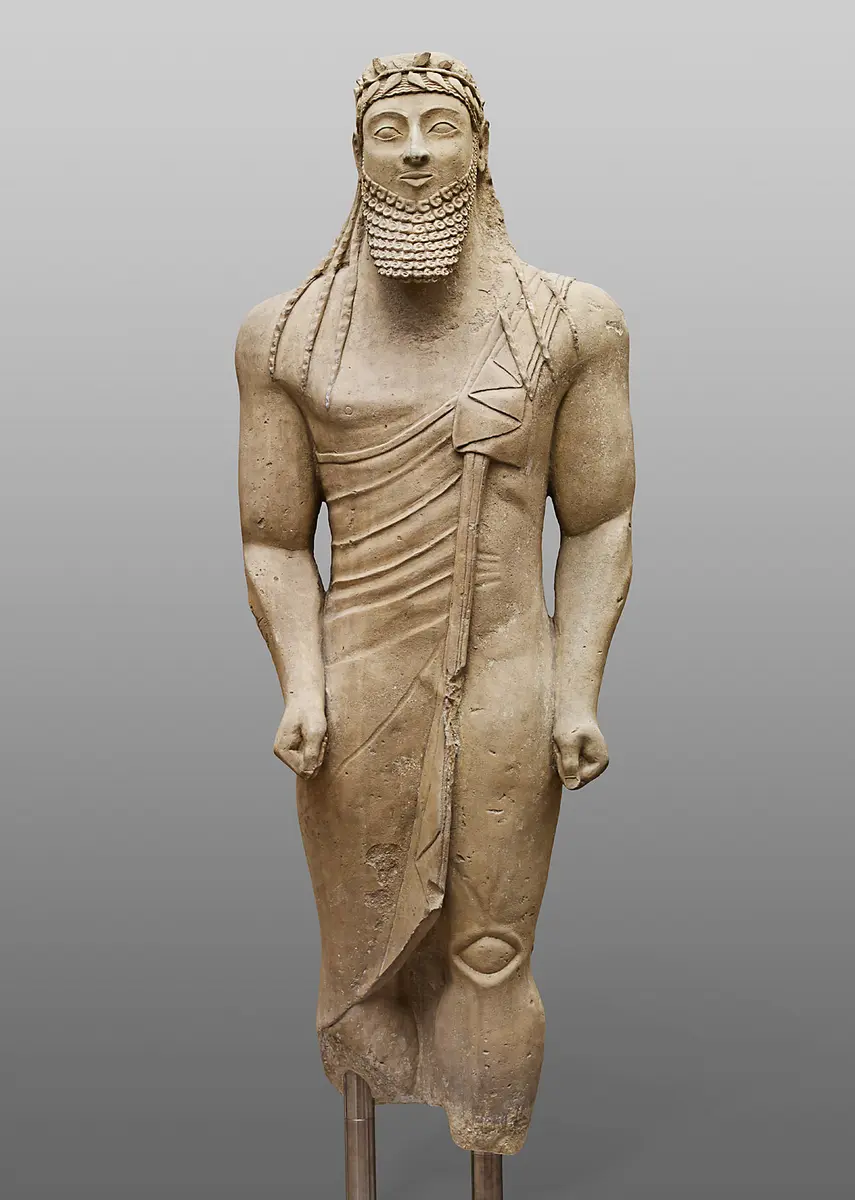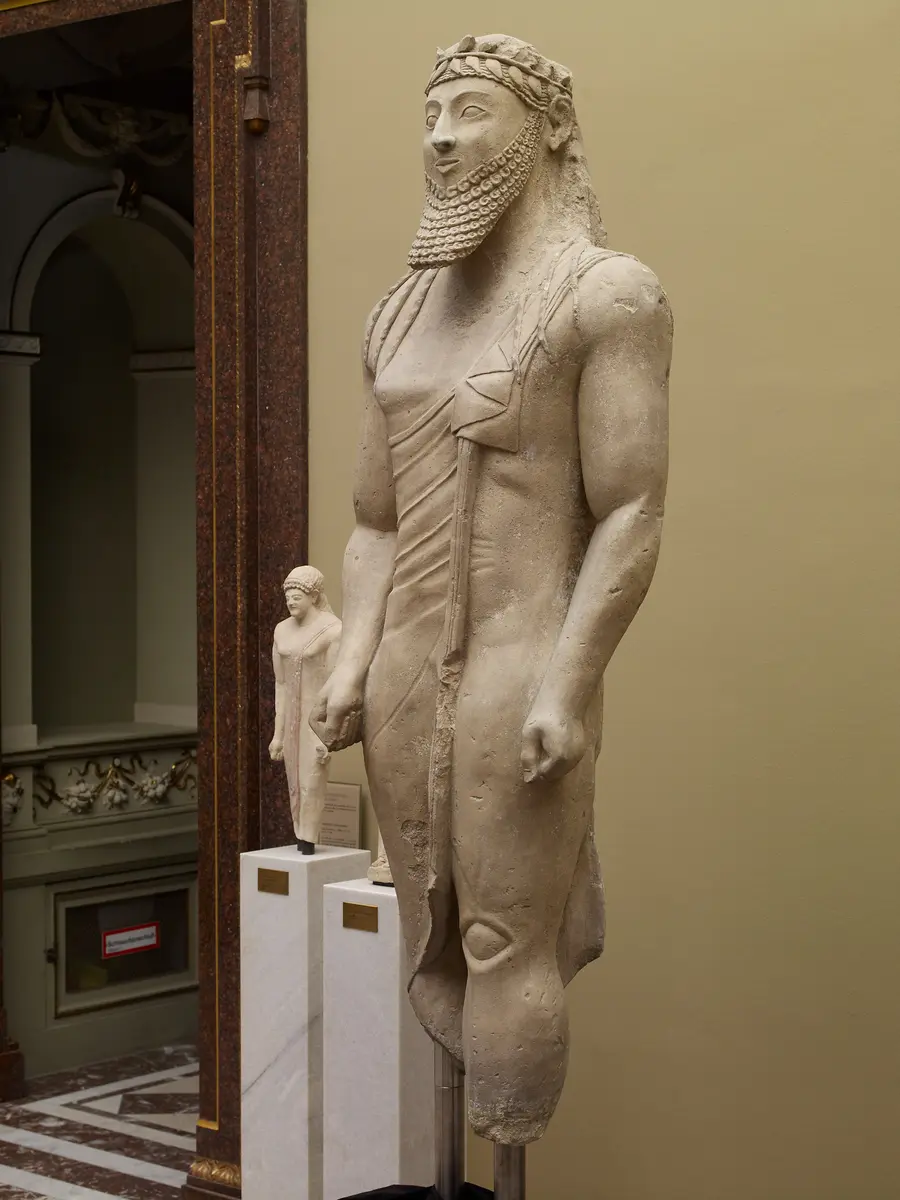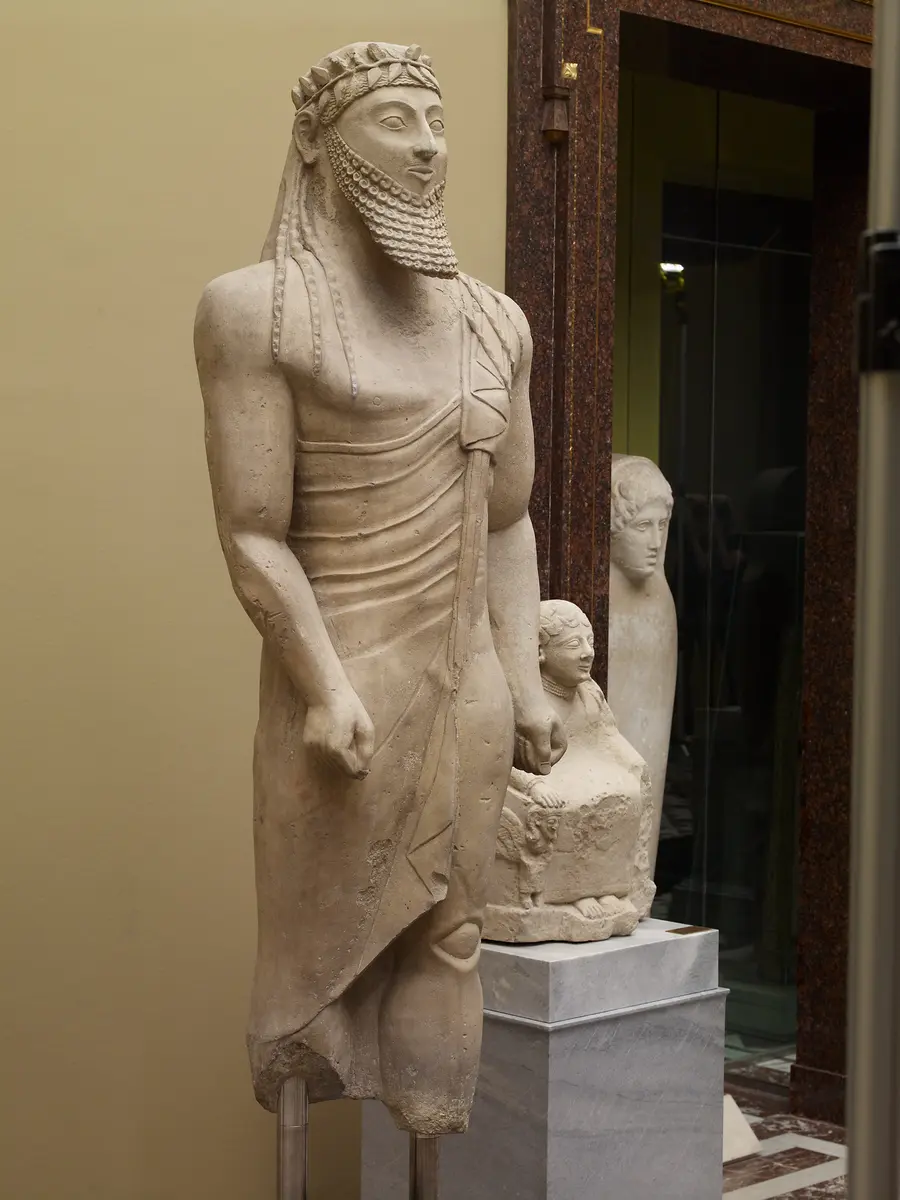Votivstatue eines Mannes
Am Beginn der griechischen monumentalen Skulptur entwickeltsich um die Mitte des 7. Jahrhunderts v. Chr. der Typus des Kuros, desunbekleideten Jünglings, der stehend, mit vorgesetztem linkem Bein und seitlichanliegenden Armen wiedergegeben wird. Die zyprischen Werke der Bildhauerkunstaus dieser Zeit, etwa die im Apollon-Heiligtum bei Pyla auf Zypern gefundeneStatue Kat.-Nr. 76, entsprechen in Aufbau und Haltung weitgehend diesem Typus.(Vgl. zur Geschichte der Statue im 19. Jahrhundert den Aufsatz von A.Bernhard-Walcher im vorliegenden Katalog.) Deutlich feststellbar sind bei denzyprischen Skulpturen jedoch auch noch andere Einflüsse; sie resultieren ausder wechselvollen Geschichte der Insel, die im 7. Jahrhundert unterassyrischer, im 6. Jahrhundert unter ägyptischer, danach unter persischerVorherrschaft stand. Wie einige Kuroi aus dem ionischen Osten, aus Samos,Pergamon und Milet, sind auch die zyprischen Statuen nach orientalischer Sittefast immer bekleidet; ihr Mantel erinnert an das schräge Mäntelchen dergriechischen spätarchaischen Koren, das ab der Mitte des 6. Jahrhunderts imionischen Osten entwickelt wurde.Die Statuen der Kuroi wurden als Weihegeschenke inHeiligtümern oder als Bild des heroisierten Toten auf Gräbern aufgestellt.Diese überlebensgroße Statue wurde in einem Apollon-Heiligtum gefunden, wohinsie wohl als Weihegeschenk gestiftet worden war.Während die Statuen der griechischen Kuroi als Zeichen ihrerJugendlichkeit bartlos sind, trägt die Statue aus Pyla einen mächtigen, ausstilisierten Ringellöckchen gebildeten Bart, der auf assyrischen Einflußzurückgeht; dazu kommt ein feiner Schnurrbart, der aus mehreren horizontalen,plastisch angegebenen Bändern gebildet wird. Das Haar ist über der Stirngewellt und fällt am Hinterkopf in breiter Masse perückenartig tief in denRücken herab, wo es jedoch, wie die gesamte Rückseite, nur grob ausgearbeitetist. Hinter den weit nach hinten versetzten und zu hoch positionierten Ohrenfallen je drei Lockensträhnen über beide Schultern auf die Brust herab, wobeiregelmäßige, wellenförmige Vertiefungen, die wie in Ton eingedrückt erscheinen,den Eindruck von geflochtenem Haar vermitteln sollen. Im Haar ein Blattkranzmit gegenständigen Blättern, die über der Stirnmitte ihre Richtung ändern.Das strahlende Antlitz wird durch die großen, mandelförmigenAugen mit den hochgezogenen Brauen, die kräftige (zum Teil ergänzte) Nase undden Mund bestimmt, dessen volle Lippen mit den leicht nach oben gezogenenMundwinkeln den Eindruck eines verhaltenen Lächelns hervorrufen. Die Statue istvon überaus kräftigem Körperbau mit breiten Schultern, einer mächtigen Brustund starker Arm- und Beinmuskulatur, wobei am linken Knie die Bildung derKniescheibe als linsenförmige Vertiefung auffällt, die fast an ein Augeerinnert. Unter dem ursprünglich roten Mantel (Farbspuren über dem rechtenOberschenkel), der die rechte Brust und die linke Körperseite freiläßt, dürftesich einst ein nur gemaltes, eng anliegendes Untergewand befunden haben (vgl.Kat.-Nr. 77). Der Mantel ist an der linken Schulter geheftet und mitbogenförmigen Falten um den Rumpf geführt; eine mehrfach zusammengefalteteStoffbahn fällt von der linken Schulter in abgetreppten, zickzackförmigenFalten nach vorn herab.Die strenge Frontalität, die Geschlossenheit des Umrissesmit den herabhängenden, leicht angewinkelten Armen und den zu Fäusten geballtenHänden sowie die Schrittstellung dieser Kuroi entstanden zweifelsohne unter demEinfluß Ägyptens. Dieser wurde auch schon in der Antike erkannt; so beschreibtzum Beispiel Diodor (I,98,9) im 1. Jahrhundert n. Chr. die Skulptur eines imKuros-Typus geschaffenen Apollon Pythios auf Samos als Statue, „die ägyptischenWerken ähnlich ist“. Von Anfang an lösen die griechischen Künstler ihre Statuenjedoch von dem Rückenpfeiler, durch den die ägyptischen Statuen dem Steinblock,aus dem sie herausgearbeitet wurden, verhaftet bleiben. Während man in Ägyptenan der einmal gefundenen Form festhält, entwickelt sich im griechischenKulturkreis im Verlauf von 150 Jahren der Typus des archaischen Kuros zurfrühklassischen Jünglingsgestalt. In Zypern allerdings verläuft diese Entwicklung(ähnlich wie in Etrurien) verlangsamt und nicht so kontinuierlich: So wirktdiese um die Wende zum 5. Jahrhundert geschaffene Weihestatue noch durchausarchaisch, wobei vor allem die nicht vollständige Trennung der Unterschenkel,die im besonderen an ägyptische Statuen erinnert, auffällt.A. Bernhard-Walcher u. a., Die Sammlung zyprischer Antiken im KHM. Sammlungskataloge des KHM Bd. 2, Wien: 1999
Title:
Votivstatue eines Mannes
Time:
550 - 525 v. Chr.
Culture:
Zyprisch
:
Pyla (Zypern)
Material/technology:
Kalkstein; Reste von Bemalung
Dimensions:
H. 201 cm
Copyright:
Kunsthistorisches Museum Wien, Antikensammlung
Invs.:
Antikensammlung, I 341
Provenance:
Lang, Sir Robert H.; Millosicz, Georg von, Wien; 1872 Kauf


